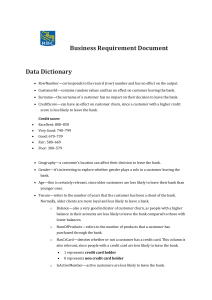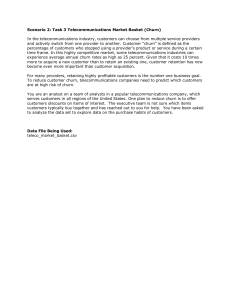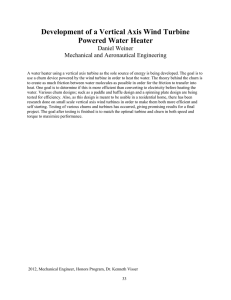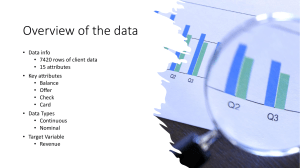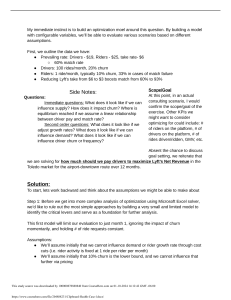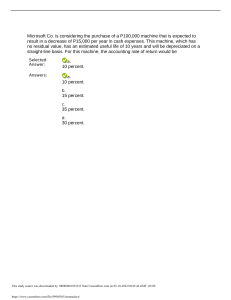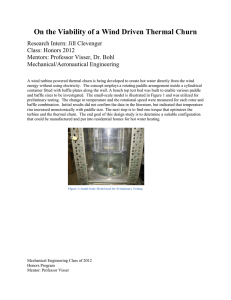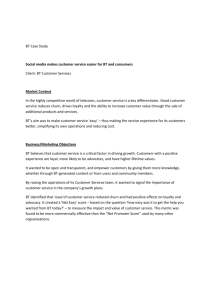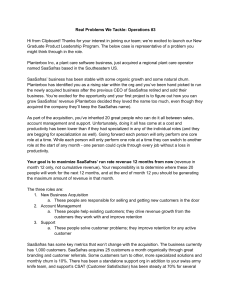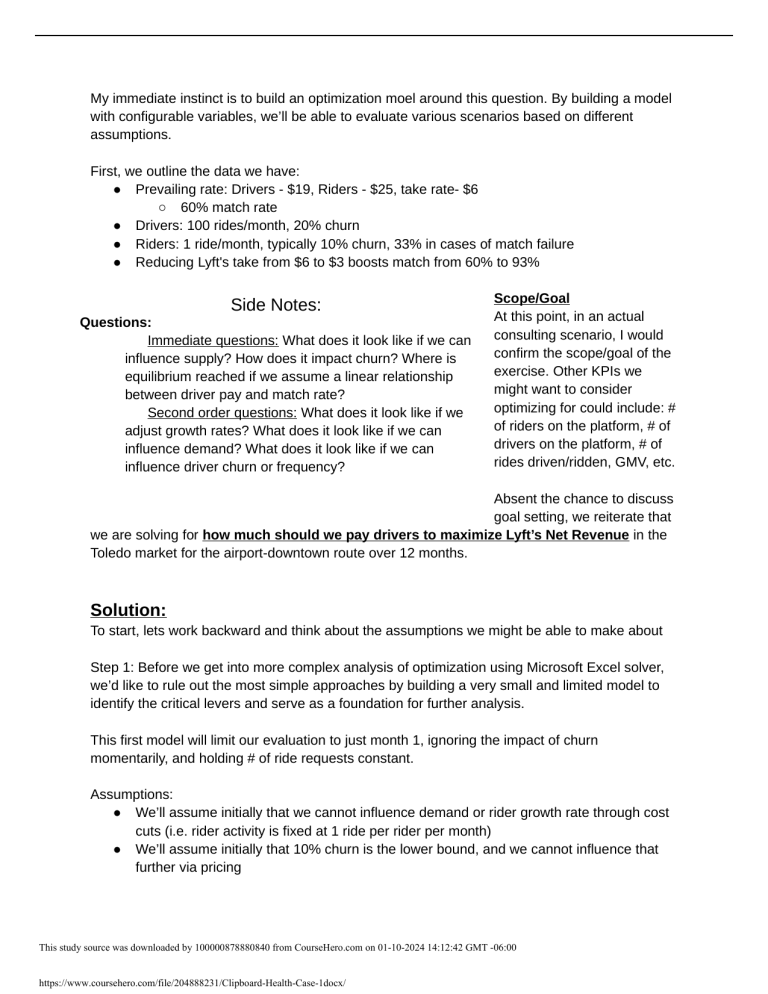
My immediate instinct is to build an optimization moel around this question. By building a model with configurable variables, we’ll be able to evaluate various scenarios based on different assumptions. First, we outline the data we have: ● Prevailing rate: Drivers - $19, Riders - $25, take rate- $6 ○ 60% match rate ● Drivers: 100 rides/month, 20% churn ● Riders: 1 ride/month, typically 10% churn, 33% in cases of match failure ● Reducing Lyft's take from $6 to $3 boosts match from 60% to 93% Side Notes: Questions: Immediate questions: What does it look like if we can influence supply? How does it impact churn? Where is equilibrium reached if we assume a linear relationship between driver pay and match rate? Second order questions: What does it look like if we adjust growth rates? What does it look like if we can influence demand? What does it look like if we can influence driver churn or frequency? Scope/Goal At this point, in an actual consulting scenario, I would confirm the scope/goal of the exercise. Other KPIs we might want to consider optimizing for could include: # of riders on the platform, # of drivers on the platform, # of rides driven/ridden, GMV, etc. Absent the chance to discuss goal setting, we reiterate that we are solving for how much should we pay drivers to maximize Lyft’s Net Revenue in the Toledo market for the airport-downtown route over 12 months. Solution: To start, lets work backward and think about the assumptions we might be able to make about Step 1: Before we get into more complex analysis of optimization using Microsoft Excel solver, we’d like to rule out the most simple approaches by building a very small and limited model to identify the critical levers and serve as a foundation for further analysis. This first model will limit our evaluation to just month 1, ignoring the impact of churn momentarily, and holding # of ride requests constant. Assumptions: ● We’ll assume initially that we cannot influence demand or rider growth rate through cost cuts (i.e. rider activity is fixed at 1 ride per rider per month) ● We’ll assume initially that 10% churn is the lower bound, and we cannot influence that further via pricing This study source was downloaded by 100000878880840 from CourseHero.com on 01-10-2024 14:12:42 GMT -06:00 https://www.coursehero.com/file/204888231/Clipboard-Health-Case-1docx/ ● Because we only have two datapoints regarding the impact of driver-pay on match rate, we’ll exclude any form of sophisticated regression analysis. For the purposes of this step (and later steps), we will assume a linear relationship between driver-pay on match rate. We will start by evaluating the simplest approach, by identifying the linear relationship between take rate and match rate to determine the impact of the upper limit, a 100% match rate, on net income. Using the algebraic equation: m= y 2− y 1 Where, the points on the graph are (3,93) and (6,60) x 2−x 1 We find that the slope is 60−93 =−11 6−3 y=−11 x +126 From here we can infer Lyft’s revenue per ride of $2.36 when the match rate hits the upper limit of 100% ● If we assume a simple model where churn is only realized at the end of the month (rather than on some form of rolling basis),and we assume that ride requests remain constant in month 1 (i.e. irrespective of match rate or take rate), we quickly see that in an isolated scenario where ride requests are denoted by some constant R, the negative relationship between take rate and match rate suggests a optimal solution near 60% fill @ $6 as 0.6($6)R>0.93($3)R>1($2.36)R. (Note:Admittedly, with a higher degree of precision, we may be able to find a solution which provides even greater returns than $6, although this ‘rounding error’ could improve the results by 1% at most.) We also note that the linear relationship between take rate and match rate may not hold above $6, at which point the driver pay would become uncompetitive with the prevailing market rate. Finally, we have demonstrated the necessity of evaluating churn as a necessary variable to evaluate in the subsequent step. Step 2: We’ll now evaluate the impact that churn may have on this relationship, over a 12 month period. We will continue to use the linear relationship discovered above as the basis for the impact of take rate, in a scenario where rider churn continues unabated (i.e. there are no new riders added to the platform at any point in the 12 month study) Assumptions: This study source was downloaded by 100000878880840 from CourseHero.com on 01-10-2024 14:12:42 GMT -06:00 https://www.coursehero.com/file/204888231/Clipboard-Health-Case-1docx/ ● ● ● ● ● ● We will assume the linear relationship between take rate and match, and that it will not hold above $6. We also assume that Lyft is not interested in subsidizing riders/drivers so negative take rate is not an option. Additionally, since we get 100% match at $2.36, our range of potential take rate is $2.36-$6 We’ll assume that rider activity is fixed at 1 ride per rider per month (i.e. we cannot influence demand through cost cuts) and that there are 100,000 riders on the platform initially We’ll assume that 10% churn is the lower bound, and we cannot influence that further via pricing For all of the above assumptions, we will assume they are static (uniform) across all days of the month and there is no variability as a result of day of the week, seasonality, etc. For the time being, we will ignore driver churn, and that there are sufficient drivers to maintain the match rate >= 60% subject to the linear equation identified above Finally, we will assume that the take rate can vary over time Results: See tab ‘Unabated Churn #1’ We ran an analysis using Excel’s solver function where the independent variable is the take rate and the dependent variable is the match rate. Since our model optimizes for cumulative net revenue at the end of 12 months, Excel prioritizes reducing rider churn in the early months via a low take rate, and gradually moves toward maximizing take rate in month 12 (at which point we are no longer concerned with rider churn). Admittedly, this model has limited utility in practice because we need to optimize beyond 12 months and the many assumptions we’ve made. However it sets a foundation for further analysis. Step 3: Given that each driver can service 100 riders (at the current rate of 100 drives per month), maintaining drivers is critical. We’ll assume this is the upper limit of driver capacity for the time being. This means that our previously established solution will have insufficient drivers due to churn following the first month. Although we previously assumed that match rate was entirely a function of take rate, we must now consider the feedback loop that driver churn has on influencing take rate. This study source was downloaded by 100000878880840 from CourseHero.com on 01-10-2024 14:12:42 GMT -06:00 https://www.coursehero.com/file/204888231/Clipboard-Health-Case-1docx/ Specifically, with each subsequent month of churn, the maximum number of rides the platform can accommodate fluctuates with the drivers available. Results: See tab ‘Unabated Churn #2’ Assuming a platform in terminal decay (which I’m not happy about assuming, but given we have positive churn, we’ll roll with it for now), each month, there will be 20% fewer drivers than the prior month. This time, since there is an evolving feedback loop, we will once again let the take-rate vary from month-to-month as riders and drivers exit the platform. Instead, we will set the # of riders matched <= number of rides available on the platform. This leads us to the following conclusion: For total platform revenue of $1,815,850 in FY1 Conclusion & Bonus Model: Since the assumption of a platform in terminal decline didn’t quite sit well with me, I decided to use the model I built and assume some negative churn. Using the same assumptions regarding a 33% churn for unmatched riders, and the linear formula for take-rate to match %, I modified the typical rider churn to -10% and the driver churn to -3% to demonstrate what a platform undergoing growth could look like. This study source was downloaded by 100000878880840 from CourseHero.com on 01-10-2024 14:12:42 GMT -06:00 https://www.coursehero.com/file/204888231/Clipboard-Health-Case-1docx/ Results: See tab ‘Bonus Sheet’ It’s admittedly imperfect; Like the previous model, churn accelerates as the model gradually moves toward maximizing take rate in month 12 (at which point we are no longer concerned with rider churn). A more sophisticated model could assign some sort of dollar penalty for each churned user (perhaps as some function of CaC). However that model, and this additional model, both seem to be out of scope for the time being. This study source was downloaded by 100000878880840 from CourseHero.com on 01-10-2024 14:12:42 GMT -06:00 https://www.coursehero.com/file/204888231/Clipboard-Health-Case-1docx/ Powered by TCPDF (www.tcpdf.org)
